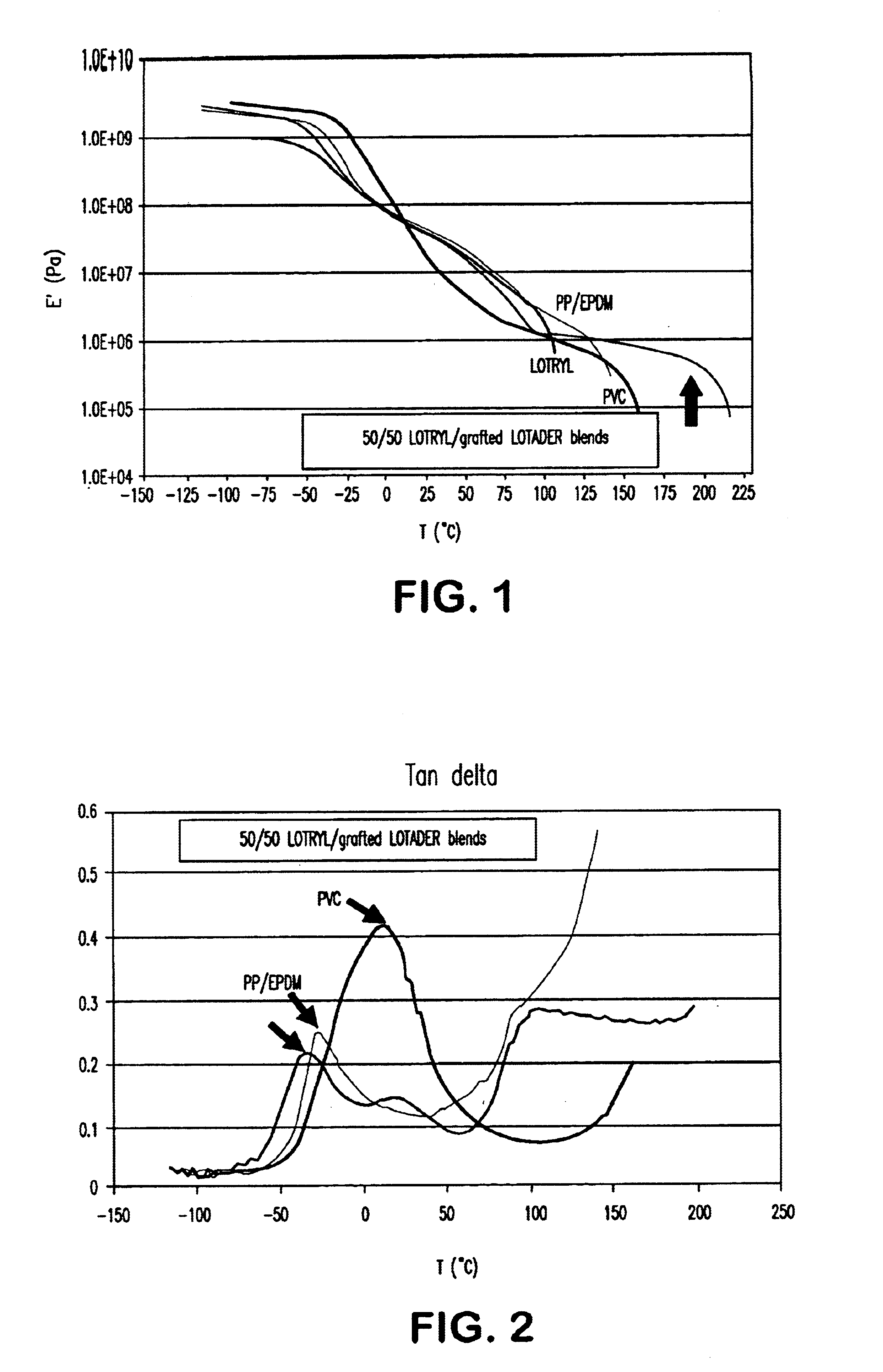Mixture of grafted polyamide-block and flexible polyolefin copolymers
a polyamide block and flexible technology, applied in the direction of transportation and packaging, basic electric elements, electric devices, etc., can solve the problems of handicaps, etc., and achieve the effect of preventing the risk of cracks, no residual stresses, and soft feeling
- Summary
- Abstract
- Description
- Claims
- Application Information
AI Technical Summary
Benefits of technology
Problems solved by technology
Method used
Image
Examples
example 1
An ethylene terpolymer, having a flexural modulus of 30 MPa, a weight-average molar mass Mw of 95 000 g / mol, copolymerized with 28% by weight of ethyl acrylate and 1.2% by weight of maleic anhydride and having a melt flow index of 6 g / 10 minutes (at 2.16 kg / 190° C.), was mixed in a Leistritz® corotating twin-screw extruder fitted with several mixing zones, having a temperature profile of between 180 and 220° C., with an amine-terminated polycaprolactam of 2500 g / mol molecular mass, synthesized as claimed in the method described in U.S. Pat. No. 5,342,886. This terpolymer contains on average 1 anhydride unit per chain. The proportions introduced into the extruder were such that the backbone polyolefin / amine-terminated polyamide ratio was 80 / 20 by weight.
The product obtained consisted, by weight, of 50% of the terpolymer to which a polyamide graft was attached, of 14% of the amine-terminated PA-6 and of 36% of the terpolymer.
The product thus produced was analysed by transmission elect...
example 2
A grafting reaction in the extruder was repeated under the conditions in Example 1 with the amine-terminated polyamide of Example 1 and an ethylene / ethyl acrylate / maleic anhydride terpolymer of 50 000 Mw, having a respective comonomer weight composition of 77 / 20 / 3, a melting point of 76° C., a flexural modulus of 30 MPa and a melt flow index of 70 g / 10 minutes (at 2.16 kg / 190° C.). This terpolymer contained 2.3 anhydride units per chain. The proportions introduced into the extruder were such that the backbone polyolefin / amine-terminated polyamide ratio was 80 / 20 by weight and the ratio of the amine functional groups to the maleic anhydride functional groups was 0.35. SEM analysis showed that the polymer obtained was organized in terms of lamellae having a thickness of about 10 nm. This polymer was characterized by an elastic modulus plateau of between 9 and 3 MPa between 80° C. and 180° C. This polymer had an elongation of 8% in the creep test under a stress of 50 kPa at 180° C.
Anal...
example 3
A grafting reaction as claimed in Example 1 was repeated with an ethylene / butyl acrylate / maleic anhydride radical terpolymer having an Mw of 105 000 and a respective weight composition of 80 / 17 / 3, a melting point of 95° C., a flexural modulus of 60 MPa and an MFI of 5 g / 10 minutes (at 2.16 kg / 190° C.) and a monoaminated PA-6 having a molecular mass of 2400 g / mol. This terpolymer contained 4.8 anhydride units per chain. The proportions introduced into the extruder were such that the backbone polyolefin / amine-terminated polyamide ratio was 80 / 20 by weight.
The polymer obtained was nanostructured. It was characterized by an elastic plateau of between 10 and 8 MPa between 100° C. and 180° C. This polymer had an elongation of 5% in the creep test under a stress of 200 kPa at 120° C. This copolymer had an elongation of 8% in the creep test under a stress of 50 kPa at 180° C.
Analysis of this polymer showed that it contained more than 50% of the terpolymer to which polyamide grafts were atta...
PUM
| Property | Measurement | Unit |
|---|---|---|
| melting point | aaaaa | aaaaa |
| melting point | aaaaa | aaaaa |
| melting point | aaaaa | aaaaa |
Abstract
Description
Claims
Application Information
 Login to View More
Login to View More - R&D
- Intellectual Property
- Life Sciences
- Materials
- Tech Scout
- Unparalleled Data Quality
- Higher Quality Content
- 60% Fewer Hallucinations
Browse by: Latest US Patents, China's latest patents, Technical Efficacy Thesaurus, Application Domain, Technology Topic, Popular Technical Reports.
© 2025 PatSnap. All rights reserved.Legal|Privacy policy|Modern Slavery Act Transparency Statement|Sitemap|About US| Contact US: help@patsnap.com



